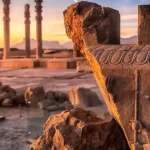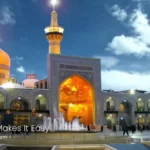Want a trip filled with history and culture that leaves unforgettable memories? Look no further than Kental Travel’s tour of Iran’s Shushtar Historical Hydraulic System. On this tour, you will witness the wonders of ancient hydraulic engineering and the beauty of the surrounding landscape as you journey back in time. A UNESCO World Heritage Site, the Shushtar Historical Hydraulic System embodies ancient Persian ingenuity. The tour offers a glimpse into the incredible engineering feats that allowed Shushtar to prosper in Iran’s arid climate. Our travel agency offers customized packages tailored to your unique interests, ensuring an enjoyable trip. So why wait? Take advantage of Kental Travel’s unique and unforgettable tour of the Shushtar Historical Hydraulic System, one of Iran’s most treasured attractions.
The Iranian Shushtar Historical Hydraulic System
As an outstanding and fascinating engineering marvel, this historical hydraulic system was built in Shushtar, Iran, during the reign of Darius the Great, the Achaemenid king of Persia. It was constructed in the 5th century BC and is considered a historical monument. A complex network of canals, dams, bridges, and tunnels was constructed to control water flow from the nearby Karun River for irrigation.
Technical Aspects of Shushtar’s Historical Hydraulic System
This system is a UNESCO World Heritage Site and represents the technological advancements of its time. One of the key features of Shushtar’s Historical Hydraulic System is the Gargar Canal, which spans 50 kilometers and was designed to provide water to the city of Shushtar. The canal is an impressive feat of engineering and is considered one of the largest and most complex water management systems of its time.
As you explore the canal, you will learn about the sophisticated technology used to design and construct it. Our knowledgeable guides will explain the use of valves and gates to control the flow of water, and how the system was able to irrigate the surrounding agricultural lands. You will also learn about the system’s strategic significance in protecting the city against enemy attacks.
Another impressive feature of the system is the Shadorvan Bridge, a dam that was built to regulate the flow of water from the Karun River. The dam is an architectural masterpiece, standing at over 500 meters in length and 50 meters in height. It was constructed using a combination of mud bricks and stones, and it still stands strong after nearly two thousand years. It was also the most eastern example of Roman bridge design and Roman dam, lying deep in Persian territory, built on Sassanid orders, and used Roman prisoners of war as labor. Despite its dual-purpose design, this structure greatly contributed to developing Sassanid water management techniques, profoundly influencing Iranian civil engineering.
Special Features of the Historical Hydraulic System of Shushtar

Due to its historical and cultural significance, as well as its technical complexity, Historical Hydraulic System of Shushtar is unique. In addition to surviving for over 2000 years, the system continues to be used today, demonstrating the ingenuity and skill of ancient Persian engineers. Kental Travel strives to provide our clients with an exceptional experience that encompasses the historical significance of the Shushtar Historical Hydraulic System and the rich cultural context of Iran and immerses them in it.
Aside from the hydraulic system, the region is home to several historical sites that should be explored. A ziggurat, a Mesopotamian pyramid-like structure, was built over 3000 years ago in the ancient city of Tchogha Zanbil, a UNESCO World Heritage Site. It offers an intriguing insight into ancient Iranian lives through its ruins.
Shushtar Waterfalls, also known as the Seven Springs, are another must-see attraction in the region, offering a stunning view of the cascading waterfalls.
Iranian cuisine is a must-try during any visit to the country. Our tour guides will take you to some of the finest local restaurants, where you will enjoy authentic Iranian dishes such as kebabs, stews, and rice dishes. You will also taste baklava and halva, traditional Iranian sweets.
Participating in the Shushtar Historical Hydraulic System tour is a once-in-a-lifetime experience. Come along as we explore Shushtar’s rich history, culture, and natural beauty.
Read more: Step By Step To Get Iran Visa
Tips for a Successful Iran Shushtar Historical Hydraulic System Tour
The following tips will help you make the most of your visit to Iran’s Shushtar Historical Hydraulic System:
- Dress appropriately: The Shushtar Historical Hydraulic System requires visitors to dress appropriately. Please wear comfortable and breathable clothing since it can become hot during the day. Furthermore, please ensure that your clothing covers your shoulders and knees to demonstrate respect for local culture.
- Wear comfortable shoes: Since you will be walking extensively during your Shushtar Historical Hydraulic System tour, comfortable shoes that provide adequate support and grip are recommended.
- Be respectful: To protect the Shushtar Historical Hydraulic System, it is paramount to respect the local culture. You should refrain from taking photographs of people without their permission, and you should not touch religious artifacts or other items of cultural significance.
- Buy souvenirs: You are encouraged to purchase souvenirs from local vendors to support the local economy. This will help sustain the community and ensure future generations can access the site.
- Learn about the technology: Gain a better understanding of the site’s significance by understanding the hydraulic system technology before taking a tour.
- Consider local customs: Respect local customs and traditions, such as removing shoes before entering a mosque or other religious building.
- Follow Guidelines: Be sure to follow all instructions given by your guide and safety guidelines at all times to ensure the safety and enjoyment of the tour.
Conclusion

With Kental Travel, you can take a personalized tour of the Iran Shushtar Historical Hydraulic System and learn about its history and unique characteristics. We will take you on an ancient exploration of this engineering marvel and its cultural significance with our knowledgeable guides. Providing exceptional service to our clients and creating customized tours based on your interests and preferences is one of Kental Travel’s primary responsibilities. Learn more about our unique tours and passionate guides at kentaltravel.com Come along and explore Iran’s hidden treasures with us and leave with unforgettable memories.
















[…] Shushtar Historical Hydraulic System, among the UNESCO Sites in Iran, located in Khuzestan Province, is an engineering marvel that showcases Iran’s ancient water management technology among the Iran World Heritage Sites. The system dates back to the 5th century BC during the Achaemenid era and includes a complex network of canals, tunnels, dams, bridges, and watermills among the Iran UNESCO Sites. […]